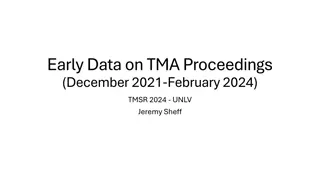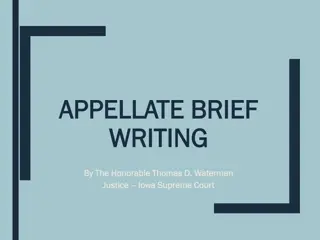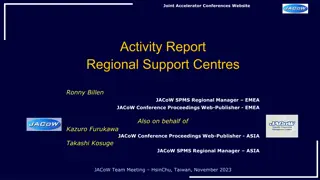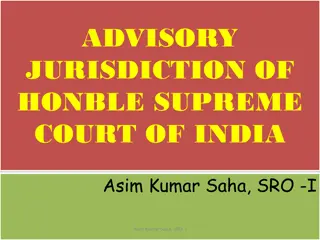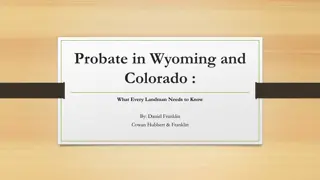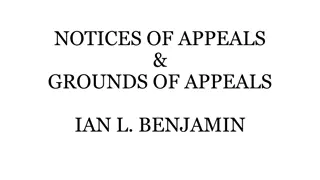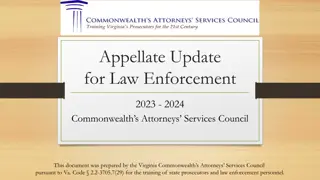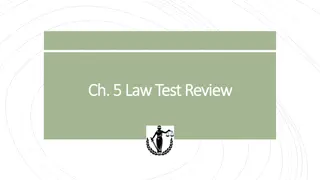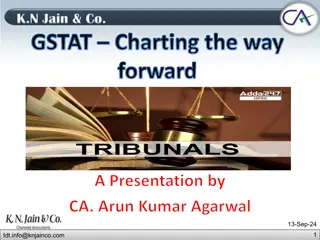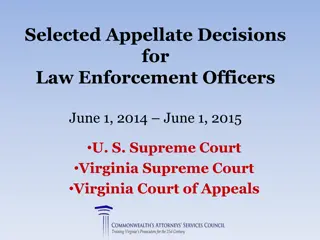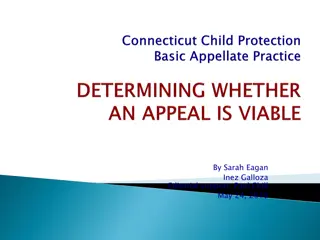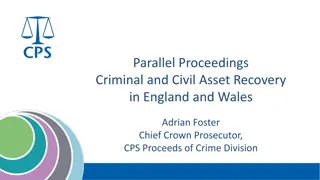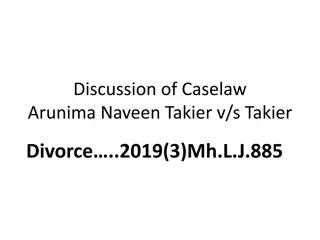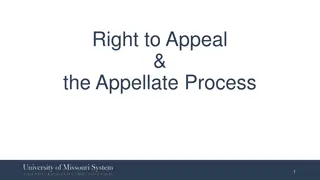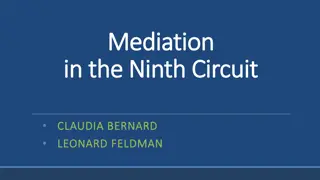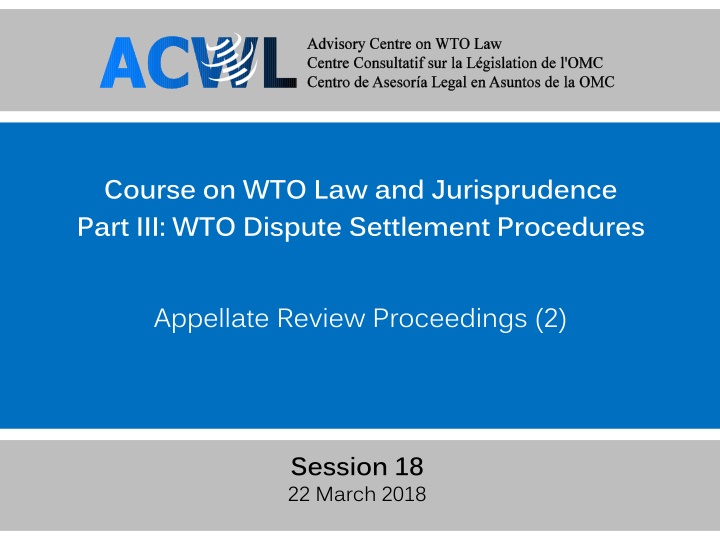
Understanding WTO Appellate Review Proceedings
Explore the decision-making process, scope, and authority of the WTO Appellate Body in dispute settlement procedures, focusing on legal analysis, drafting documents, and oral argumentation. Learn about the high standard set for Article 11 appeals and the review of factual determinations.
Download Presentation

Please find below an Image/Link to download the presentation.
The content on the website is provided AS IS for your information and personal use only. It may not be sold, licensed, or shared on other websites without obtaining consent from the author. If you encounter any issues during the download, it is possible that the publisher has removed the file from their server.
You are allowed to download the files provided on this website for personal or commercial use, subject to the condition that they are used lawfully. All files are the property of their respective owners.
The content on the website is provided AS IS for your information and personal use only. It may not be sold, licensed, or shared on other websites without obtaining consent from the author.
E N D
Presentation Transcript
Course on WTO Law and Jurisprudence Part III: WTO Dispute Settlement Procedures Appellate Review Proceedings (2) Session 18 22 March 2018
AGENDA 1. How does the Appellate Body decide? 2. Scope of appellate review Appeals in respect of Article 11 of the DSU Completing the legal analysis Should the AB have remand authority? 3. Drafting documents for appellate proceedings 4. Arguing a case at the oral hearing
HOW DOES THE AB DECIDE? The Appellate Body makes decisions by consensus Working Procedures emphasise the principle of collegiality in decision making. Where the Members cannot reach consensus, they will decide on the basis of a majority. Appellate Body members may also issue separate affirming or dissenting opinions, but these have to be anonymous. Not an unusual option: dissenting opinions provided for in domestic courts and international tribunals.
WHAT CAN THE APPELLATE BODY DO? Article 17:6 of the DSU: "An appeal shall be limited to issues of law covered in the panel report and legal interpretations developed by the panel."
WHAT CAN THE APPELLATE BODY DO? Legal interpretation Appellate Body Panels Application of legal standard to facts Factual basis
ARTICLE 11 OF THE DSU Article 11 of the DSU: "a panel should make an objective assessment of the matter before it, including an objective assessment of the facts of the case and the applicability of and conformity with the relevant covered agreements . . ."
ARTICLE 11 OF THE DSU The panel's factual determinations and its weighing and balancing of the evidence is not subject to appellate review. HOWEVER: The question of whether the panel made an objective assessment of the facts as required by Article 11 of the DSU is a legal question subject to appellate review.
ARTICLE 11 OF THE DSU The Appellate Body has traditionally set a very high standard for Article 11 appeals. EC Hormones: The AB can examine "egregious" errors such as the "disregard", "distortion" or "misrepresentation" of evidence. EC Asbestos: Panels enjoy a margin of discretion as triers of fact. The Appellate Body will not "interfere lightly" with the panel's discretion. DR Cigarettes, US Clove Cigarettes: Not every error by the Panel amounts to an Article 11 violation.
ARTICLE 11 OF THE DSU In EC Fasteners (China), the Appellate Body summarized the panel's duties as a trier of facts under Article 11 of the DSU. The Panel: must base its finding on a sufficient evidentiary basis on the record, must not apply a double standard of proof, must treat evidence in an even-handed manner, must consider the evidence before it in its totality and should not disregard evidence that is relevant to the case of one of the parties.
ARTICLE 11 OF THE DSU In China Rare Earths, however, the Appellate Body sought to discourage Article 11 claims and stated that an Article 11 claim is "a very serious allegation": "We wish to encourage appellants to consider carefully when and to what extent to challenge a panel's assessment of a matter pursuant to Article 11 . . ." "An Article 11 claim must be clearly articulated and substantiated with specific arguments, including an explanation of why the alleged error has a bearing on the objectivity of the panel's assessment".
COMPLETING THE ANALYSIS In accordance with Article 17.13, the Appellate Body may uphold, modify, or reverse the panel's findings and conclusions. In some situations, the issues may be left unresolved: If the Panel exercises judicial economy and the AB reverses If the AB modifies the Panel's findings In these situations, the AB may "complete the analysis" by ruling on those claims.
COMPLETING THE ANALYSIS Panel's exercise of judicial economy Canada Periodicals Article III:2 of the GATT: First sentence: "like" products Second sentence: "directly competitive" products Panel Finds that the products at issue are "like". Exercises judicial economy on whether the products are "directly competitive". Appellate Body It reverses the Panel's finding that the products are "like". Can it examine if the products are "directly competitive"?
COMPLETING THE ANALYSIS Appellate Body modifies the Panel's finding US COOL Panel interpreted Article 2.1 of the TBT Agreement as requiring only detrimental impact on imports. Appellate Body found that Article 2.1 of the TBT Agreement requires examining whether the detrimental impact stems exclusively from a legitimate regulatory distinction. Could the AB complete the analysis as the whether, in that case, the detrimental impact stemmed exclusively from a legitimate regulatory distinction?
COMPLETING THE ANALYSIS The AB can complete the analysis only if: the relevant factual findings in the panel report are complete, or the relevant facts in the panel record were "undisputed" by the parties; and there is a "logical continuum" between the issues reversed or modified and the issues on which the legal analysis should be completed. The issue has been sufficiently explored by the parties and the panel. (EU Seal Products)
COMPLETING THE ANALYSIS In EC Large Civil Aircraft, the AB stated explicitly that "the Appellate Body has exercised restraint in completing the analysis in past disputes." Some panels have responded by elaborating in detail the factual findings that may be required if their initial findings are reversed. For example, in US COOL (21.5) the panel developed extensive findings on the non-violation claim to enable the AB to complete the analysis in the event the violation findings were reversed.
SHOULD THE APPELLATE BODY HAVE REMAND AUTHORITY? What if the panel did not make factual findings at all? Theoretically, the Appellate Body would have to stop the examination of the issue and leave it undecided as it cannot complete the analysis. This may mean going back to "Step One" for complainant. The alternatives are: To expand the competences of the Appellate Body to issues of fact; To provide the Appellate Body with remand powers (focus of current DSU proposals).
SHOULD THE APPELLATE BODY HAVE REMAND AUTHORITY? Proposals: The AB provides parties with detailed description of findings required. Either party may activate remand. Remand implementation of reports. does not affect adoption and Only after the panel reports back to AB, the AB issues its final report.
DRAFTING DOCUMENTS FOR APPELLATE PROCEEDINGS Notice of appeal Day 18 Day 0 Appellant Appellee's submission Appellant's submission and Executive Summary Oral Day 0 statement Oral Appellee's submission statement Notice of Other Appeal Day 5 Appellee Other Appellant's submission and Executive Summary Day 21 Day 5 Third participants
NOTICE OF APPEAL/NOTICE OF OTHER APPEAL 1995: Notice of Appeal must include a "brief statement of the nature of the appeal". No Notice of Other Appeal required. 2005: Notice of Appeal/Notice of Other Appeal must include: (i) Alleged error(s) in law that the panel is alleged to have made; (ii) List of legal provision(s) in the covered agreements that the panel is alleged to have erred in interpreting or applying; (iii) List of the specific paragraphs of the panel report containing the alleged error(s).
EXECUTIVE SUMMARIES 2010: Executive Summaries filed at time of the submissions. Submitted by parties used by Appellate Body Secretariat to summarize arguments of the parties. 2015: Executive Summaries to be submitted by parties and third participants and annexed to AB Report (without revision by Secretariat). Maximum length of Executive Summary is 250 words or 10% of word count of the written submission, whichever is longer.
SUBMISSIONS BY PARTIES Appellant's Submission Article 21(1) and (2) WP File on day of Notice of Appeal Appellee's Submission Article 22(1) and (2) WP File 18 days after Notice of Appeal Precise statement of the grounds for opposing the specific allegations of errors in the issues of law covered in the panel report and legal interpretations developed by the panel raised in the appellant's submission, and the legal arguments in support thereof; Precise statement of grounds for the appeal, including specific allegations of errors of law and legal arguments in support; precise statement of the provisions of the covered agreements and other legal sources relied on; and Acceptance of, or opposition to, each ground set out in the appellant's submission; Nature of the decision or ruling sought. Precise statement of the provisions of the covered agreements and other legal sources relied on; and Nature of the decision or ruling sought.
THIRD PARTICIPANT SUBMISSIONS Rule 24 of the Working Procedures. To be filed within 21 days after the Notice of Appeal Filing a submission not compulsory. If third participant does not file a written submission, it must notify within 21 days whether it intends to appear at oral hearing and whether it intends to make an oral statement. Third participants can also notify at the earliest opportunity after the 21-day period.
ARGUING A CASE AT THE ORAL HEARING The procedures are adjusted on a case-by-case basis. The Presiding Member may set time-limits for oral arguments. Participants' opening statement: 20-30 minutes. Third participants statements: 10 minutes. Questions from the Division (Parties cannot question each other). Concluding statements Appellant Appellant 3rd Part. Q&A Appellee Appellee
ANATOMY OF AN APPELLATE BODY REPORT Appellate Body Report Indonesia - Import Licensing .pdf oArguments of the participants and third participants oIssues raised in the appeal oAnalysis of the Appellate Body oFindings and Conclusions Appellate Body Report Indonesia - Import Licensing Addendum.pdf oNotice of Appeal oExecutive summaries of participants and third participants

